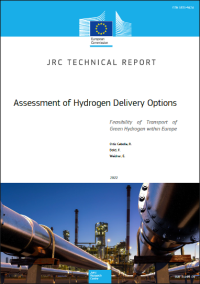This report analyses several options for hydrogen delivery in order to provide relevant insights and techno-economic information to stakeholders, and to provide support to policymakers in the implementation of the hydrogen strategy.
 The RePowerEU plan sets an ambitious target of 10 million tonnes of renewable hydrogen imports by 2030. Already the European Hydrogen strategy had foreseen that hydrogen may have to be transported within Europe, or even imported from the EU’s eastern and southern neighbours, which are seen as potential exporters of clean hydrogen to Europe. It is therefore important to understand whether it is cost effective to produce renewable hydrogen where renewable electricity is cheap and then transport it to the customer or it is better to produce the renewable hydrogen close to the demand location. If transporting hydrogen makes sense, a second open question is how long the transport route should be for the cost of the hydrogen to still be competitive with locally produced hydrogen. The development of an infrastructure connecting areas rich in renewable energy with areas with high demand for hydrogen will need significant investment and should therefore be planned in a coordinated manner, at a European level. As there are multiple options available, it is necessary to investigate their advantages and disadvantages, in order to guide infrastructure development along the most effective path.
The RePowerEU plan sets an ambitious target of 10 million tonnes of renewable hydrogen imports by 2030. Already the European Hydrogen strategy had foreseen that hydrogen may have to be transported within Europe, or even imported from the EU’s eastern and southern neighbours, which are seen as potential exporters of clean hydrogen to Europe. It is therefore important to understand whether it is cost effective to produce renewable hydrogen where renewable electricity is cheap and then transport it to the customer or it is better to produce the renewable hydrogen close to the demand location. If transporting hydrogen makes sense, a second open question is how long the transport route should be for the cost of the hydrogen to still be competitive with locally produced hydrogen. The development of an infrastructure connecting areas rich in renewable energy with areas with high demand for hydrogen will need significant investment and should therefore be planned in a coordinated manner, at a European level. As there are multiple options available, it is necessary to investigate their advantages and disadvantages, in order to guide infrastructure development along the most effective path.
JRC has performed a comprehensive study regarding the transport of hydrogen. To investigate which renewable hydrogen delivery pathways are favourable in terms of energy demand and costs, JRC has developed a database and an analytical tool to assess each step of the pathways, and used it to assess two case studies. The first case study is for a simple point A to point B delivery route, assessing shipping and pipeline transport, whereas a second case analyses a more complex distribution route. This report analyses several options for hydrogen delivery in order to provide relevant insights and techno-economic information to stakeholders, and to provide support to policymakers in the implementation of the hydrogen strategy.
